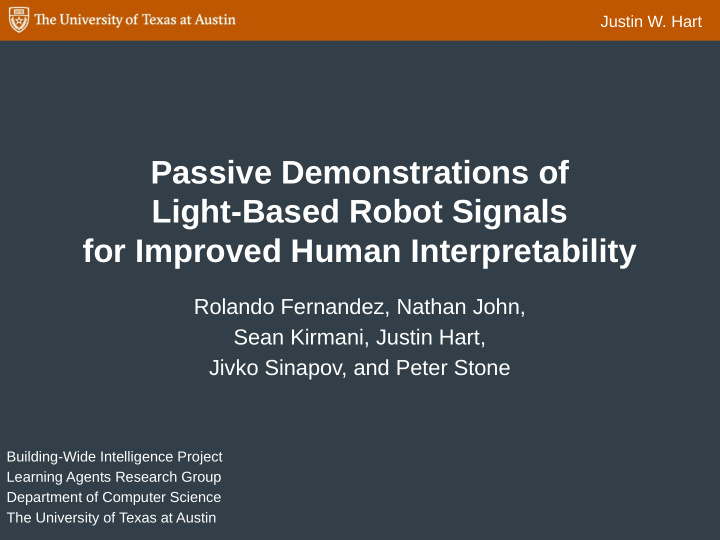



Justin W. Hart Passive Demonstrations of Light-Based Robot Signals for Improved Human Interpretability Rolando Fernandez, Nathan John, Sean Kirmani, Justin Hart, Jivko Sinapov, and Peter Stone Building-Wide Intelligence Project Learning Agents Research Group Department of Computer Science The University of Texas at Austin
Justin W. Hart Building-Wide Intelligence ● Real-world deployment ● Fleet of autonomous service robots – 5 (soon to be 7!) ● Respond to verbal commands ● Intended to provide services to the building’s occupants
Justin W. Hart Navigating Crowded Spaces ● The robots navigate crowded hallways ● This can lead to navigational conflicts where the robot and person want to walk into the same place.
Justin W. Hart The Hallway Problem
Justin W. Hart Solution: LED Turn Signals Right Turn Left Turn
Justin W. Hart Hallway Test Environment
Justin W. Hart Modeling the Hallway – 3 Traffic Lanes
Justin W. Hart Robot Behavior ● Hallway – 17x1.85 meters ● Signal – 7 meters from the person ● Execute – 2.75 meters from the person ● Conflict – 1 meter from the person
Justin W. Hart Pilot Study ● 13 participants (9 male, 4 female) ● Recruited primarily from the UT Austin Engineering and Computer Science. ● Procedure ● Informed consent & media release ● Participants walked once down the test hallway with the robot going the opposite direction ● Survey ● Results ● Half interpreted the signal the direction they should take. ● Half interpreted the signal like a turn signal.
Justin W. Hart New Approach – Passive Demonstration ● Want to demonstrate the signal with no explicit training period. ● Idea – Passive Demonstration ● Have the robot use the signal in context before it is explicitly needed in the interaction with the participant. ● Robot makes a lane change at the start of the hallway.
Justin W. Hart Study Design Study Conditjons Passive Demonstratjon No Demonstratjon Demonstratjon LED Signal No LED No Demonstratjon, Demonstratjon, LED No LED No LED LED No Demonstratjon, Demonstratjon, LED LED
Justin W. Hart Study • 47 Participants (39 male, 8 female) ● Recruited primarily from the UT Austin Engineering and Computer Science. ● Procedure ● Informed consent & media release ● Participants walked once down the test hallway with the robot going the opposite direction ● Survey • Additional 11 participants (8 male, 3 female) recruited for a follow-up condition.
Justin W. Hart No Demo, No LED
Justin W. Hart
Justin W. Hart No Demo, LED
Justin W. Hart
Justin W. Hart Demo, No LED
Justin W. Hart
Justin W. Hart Demo, LED
Justin W. Hart
Justin W. Hart Passive Demonstrations Reduce Conflict
Justin W. Hart Conclusion • We thought the meaning of the LED turn signals would be obvious to users. – It was not. • Introduction of the concept of the passive demonstration of the signal. – Effective in demonstrating the meaning of the signal to users.
Recommend
More recommend